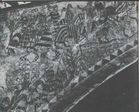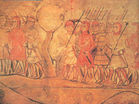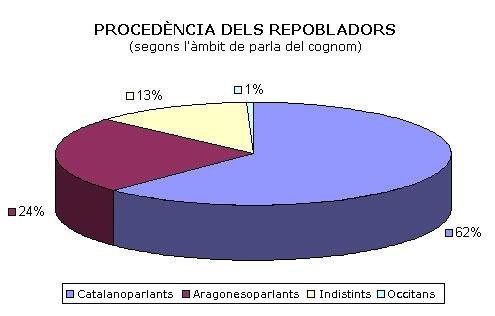<< | Índex | >>
Origin of the settlers

Modern copy of a lost miniature of the "James I's Chronicle" (or «Llibre dels Feyts») manuscript, in which the proposal directed towards James I to conquer Valencia is made.
One of the great myths surrounding the history of Blaverism, which accompanies the vast majority of its texts and arguments is the Llibre del repartiment (Book of Distribution). Simplistic ideas and hasty, therefore erroneous, conclusions have been drawn from this book and the data it contains. It should be noted that the real distribution of Valencian settlers was made in three main stages, and that the Book of Distribution does not contain them all. In addition, it does not follow an order - that is to say, the book contains data of each stage, with different quality and quantity. This means that, depending on the interpretation of the data, we can say that Catalan settlers were not even 5% of total settlers in the Valencian Country. It is worth noting that, in the 1970's, A. Ubieto and M.D. Cabanes studied this data, using it to justify their linguistic secessionism - according to them, if 5% (!) of the settlers were Catalan, they could not have implemented their language, and since it is also clear that Valencian does not come from Aragonese, they could conclude that Valencian is a language of local origin, of the Moors, of the Mozarabs, or of a mixture containing something from every local language.

Group of Catalan and Aragonese knights around James I, during a military operation. Castle of Alcanyiç.
The Book of Distribution is NOT the book of Repopulation. The vision of this specific text is limited in time and space. But it is also a book consisting of various notebooks, bound (in some cases, disorderly), with repetition of content and with obvious information gaps. In addition, the distribution of settlers described in this book is not limited to the precise moment of the concession of a house or a parcel of land, but any person who received it could resell it, relocate, leave, and so on. It makes us vary the results even more. It could be very probable that in the document, mentions of the single name of one military leader represented a group of people (such as his subordinates or comrades), which does not lead us to believe that this data extraction system is the correct one, or at least the best one.
It is true that the Llibre del repartiment is a good photograph of the moment it describes, but if we have to study the ENTIRE repopulation of the Kingdom of València we cannot take it as the only source. It must be completed with private and local documentation from the 13th century, similarly to what Valencian historian Enric Guinot did in his work called Els fundadors del regne de València (The founders of the Kingdom of València). València. Ed Tres i Quatre., in which he works with more than 25000 Valencian documents from that period, which suppose more than 125000 personal files.
Muslim population continuity has also been one of the Blaverists' arguments. On one hand it is true that Muslims did not suffer definitive expulsion until 1609, but on the other hand it is also true that many of them had been expelled since the 13th century.

James I of Aragon's army marching to conquer València. Old Royal Palace of Barcelona.
Thirdly, there also exists a myth about the duality of population and geographical situation between Aragonese and Catalans. The Aragonese would have settled inland, as feudal lords, while the Catalans would have remained in the coastal areas, in the more economically active urban society.
The dualism between Catalans and Aragonese defends a Valencian Country divided into two parts, in its origin. However, it seems that medieval texts and chronicles of the time unanimously state that the vast majority of the settlers were Catalan (see the graphs of origin of the population). According to this data, dualism is nowhere to be found, although it is true that James I of Aragon and Peter III the Great of Aragon had conflicts, even violent ones, with the Aragonese nobility over the distribution of the new jurisdictions in the Kingdom of València.
As a counterevidence to the argument that states that Valencian is a language different from Catalan because of the simple old nomenclature, there are these words attributed to Francesc Eiximenis himself (14th century): [(...) com sia vengut e eixit, per la major partida, de Catalunya, e li sia al costat, emperò no es nomena poble català, ans per especial privilegi ha propi nom e es nomena poble valencià. ((...) even though it came, for the most part, from Catalonia, and it is next to it, it is not called Catalan people, but by special privilege has its own name and is called Valencian people).] (Government of the Republic. Barcelona, Ed. Barcino. (1927) p.35. There are many texts that talk about this issue, but this is probably the most illustrative one.
It is worth mentioning in any case that this quotation seems to be from the XVth century, and possibly it was not written by Eiximenis. It possibly comes from the hand of some Valencian (-s) who inserted it in the incunabulum edition of the Regiment of the Public Thing from 1499, as we will explain in more detail in another section of this website. One can find by the way a facsimile online reproduction of this beautiful incunabulum edition.
In any case, this would further reinforce the prove that Valencians' consciousness of coming from Catalonia was still alive two centuries after James I's conquest.












